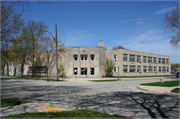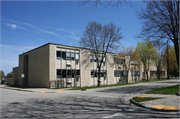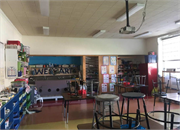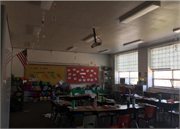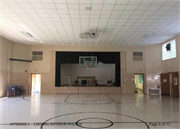Property Record
100 S HURON ST
Architecture and History Inventory
| Historic Name: | St. Mary Catholic School |
|---|---|
| Other Name: | Notre Dame School |
| Contributing: | |
| Reference Number: | 121458 |
| Location (Address): | 100 S HURON ST |
|---|---|
| County: | Brown |
| City: | De Pere |
| Township/Village: | |
| Unincorporated Community: | |
| Town: | |
| Range: | |
| Direction: | |
| Section: | |
| Quarter Section: | |
| Quarter/Quarter Section: |
| Year Built: | 1952 |
|---|---|
| Additions: | 1960 |
| Survey Date: | 20012017 |
| Historic Use: | school – elem/middle/jr high/high |
| Architectural Style: | Art Deco |
| Structural System: | |
| Wall Material: | Limestone |
| Architect: | Foeller, Schober, Berners, Safford and Jahn; John Tilleman (1960) |
| Other Buildings On Site: | |
| Demolished?: | No |
| Demolished Date: |
| National/State Register Listing Name: | Not listed |
|---|---|
| National Register Listing Date: | |
| State Register Listing Date: |
| Additional Information: | St. Mary's convent is located adjacent to the building. An addition was completed at the west end of the school building in 1960. 2017 survey recommendation write-up: This property consists of a two-story, flat-roofed, Contemporary-style school building (1952; 1960), and a two-story, flat-roofed Contemporary-style former convent building (1959), both associated with St. Mary Catholic Church. Regarding the former, the school rises two stories, the entrance of which is oriented to the intersection of S. Huron & Charles streets and accessed via a short set of stairs. Faced with smooth cut stone and exhibiting an Art Deco-style influence, the entry block is canted on each side, with the central portion divided into three bays. The central section is comprised of a double-door entry above which rests a pair of replacement double-hung sash. Between each floor is a cut-stone panel that includes a variety of carved stone ornament. Similarly, the outer two bays include a door along the first floor and a sash window on the second, along with a central, cut-stone panel with additional but less ornate, carved ornament. The stone coping exhibits a geometric design. To the north is a two-story, limestone-sheathed classroom wing that includes large expanses of windows with (original) glass block on both levels. To the west and along Charles Street, the original 1952 gymnasium block carries windows--a single expanse of multiple-lights--only along its first level, while the second floor is devoid of fenestration. The two-story, flat-roofed, 1960 classroom addition to the west is built of pre-cast concrete. Limestone sections alternate with sections of metal-frame windows along both floors. Located at 133 S. Superior Street and north of the school is the former convent. Its exterior is similar to the 1960 classroom addition in that it features two-story expanses of limestone that alternate with window bays along both its north and south elevations. In this case, windows are slider examples. An entrance sheltered by a flat-roof overhang is evident along S. Superior Street. St. Mary’s Catholic congregation was formed as Immaculate Conception parish after breaking away in 1869 from the Irish Catholics. Their first church was completed in 1870 (on the subject block) and, in 1882, a school was established. Eight years later (1890), a rectory was built and, in 1912, a convent erected. In need of larger school facilities, the congregation engaged the Green Bay firm of Foeller, Schober, Berners, Safford and Jahn to design a modern school. Len G. Ries served as general contractor, with groundbreaking ceremonies held in June 1951. Dedicated in October 1952, the facility included twelve classrooms, a gymnasium, library, kitchen and music room and the earlier school building was demolished. Seven years later, a new convent was built from designs provided by Green Bay architect John Tilleman , who was also responsible for the 1960 school addition (which also included office space and a finished basement with kitchen and dining facilities, as well as lockers). In 1971, St. Mary School consolidated with St. Francis Xavier School and was renamed Notre Dame. It is identified as one of the earliest school consolidations in the Green Bay Diocese. In 1994, the Diocese recommended that St. Mary build a new church at a new location. Groundbreaking occurred in 1997 and dedication of the new church—designed by Birschbach & Associates, Ltd., was held on 29 March 1998. The following year, the old church was demolished; however, the stained-glass windows of the church, as well as much of the church furniture, were reinstalled in the new facility (located at 4805 Sportsman Drive). |
|---|---|
| Bibliographic References: | 2001: Berners-Schober Associates, Inc. archives; City inspection office. Citations for 2017 survey information found below in Additional Comments: An outline of the history of St. Mary’s church can be found on the church’s website, Available online at www.stmarydepere.org/pdf/History.pdf, Accessed July 2017; “$185,000 in Bonds to Finance School,” Green Bay Press-Gazette, 9 January 1952, 8; Photo and caption (re: shovel turning), Green Bay Press-Gazette, 28 June 1951, 44; “Bishop Bona Will Dedicate School on Sunday,” Green Bay Press-Gazette, 18 October 1952, 22; “New Convent,” photo and caption, Green Bay Press-Gazette, 12 November 1959, 48; “School Addition Progress,” photo and caption, Green Bay Press-Gazette, 16 March 1960, 37; “2,000 Pupils Expected in Parochial Schools,” Green Bay Press-Gazette, 24 August 1960, 21; George S. Koyl, ed., American Architects Directory (New York: R. R. Bowker, 1962), 705. |
| Wisconsin Architecture and History Inventory, State Historic Preservation Office, Wisconsin Historical Society, Madison, Wisconsin |

